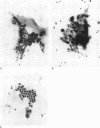Abstract
BACKGROUND: Bile duct strictures may be benign or malignant. A definite diagnosis is desirable to advise patients of their prognosis and to identify any amenable to curative surgery. AIMS: To compare different methods of cytology sampling from biliary strictures and evaluate the use of cytology in this context. PATIENTS AND METHODS: In a prospective study 54 patients undergoing endoscopic retrograde cholangiopancreatography (ERCP) had cytology samples obtained as follows: (1) biliary stricture brushings, (2) from the screw thread of a "Soehendra stent retriever" inserted through the stricture, (3) from the proximal end of a blocked biliary stent, and (4) cellular material spun down from a 20 ml specimen of bile. Examination of slides and rinsings was performed by an expert cytologist who graded them for the adequacy of the sample and for evidence of malignancy. RESULTS: Prolonged follow up disclosed malignancy in 52 of the 54 cases, the other two being chronic pancreatitis. Bile samples provided adequate cytology samples in 44%, the Soehendra stent retriever in 70%, retrieved stents in 84%, and cytology brush sampling in 96%. Overall, 28 malignancies were detected by cytology, including 14 of 28 pancreatic carcinomas and 12 of 16 cholangiocarcinomas. Twenty two of the malignancies were detected by brush sampling and the other methods added a total of another six cases. CONCLUSIONS: Cytology sampling is best done by brushing the biliary stricture. Cytology sampling can confirm the diagnosis in 75% of cholangiocarcinomas and 50% of pancreatic carcinomas. The techniques involved are simple to perform and should be routine clinical practice whenever potentially malignant biliary strictures are encountered at ERCP.
Full text
PDF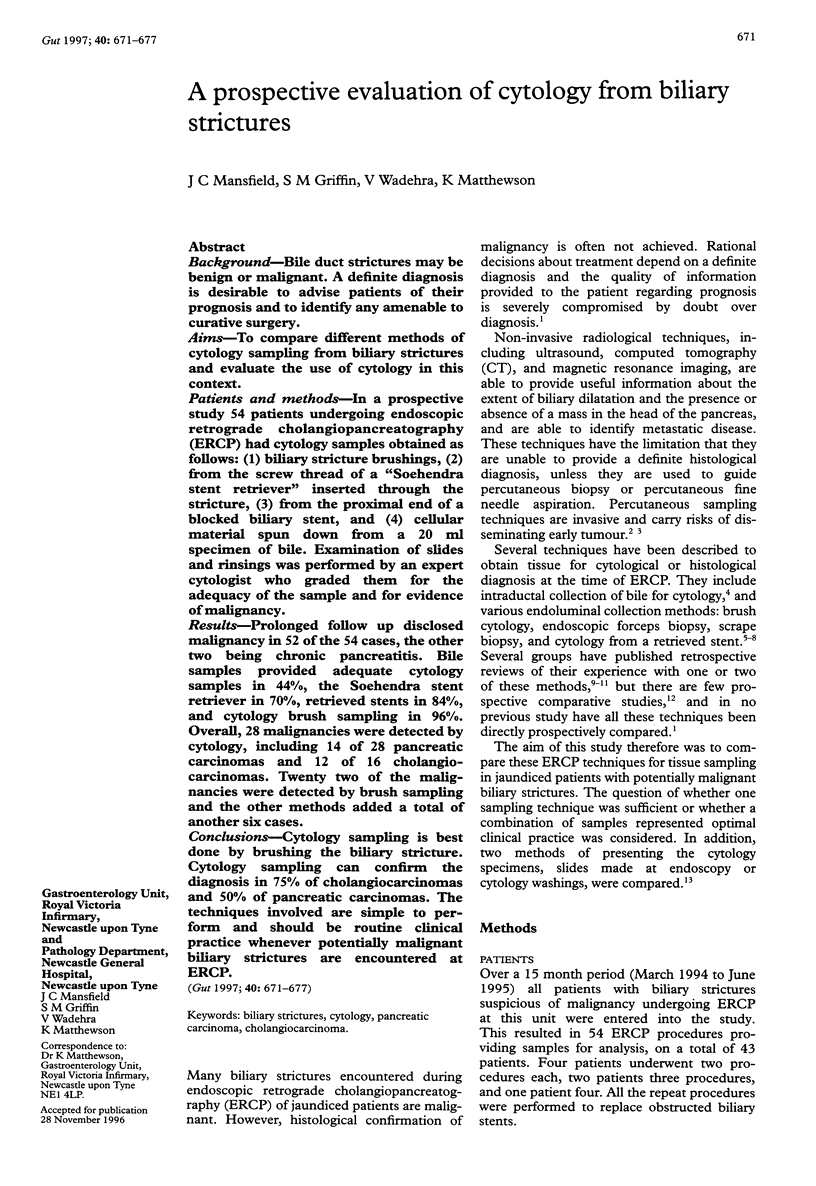
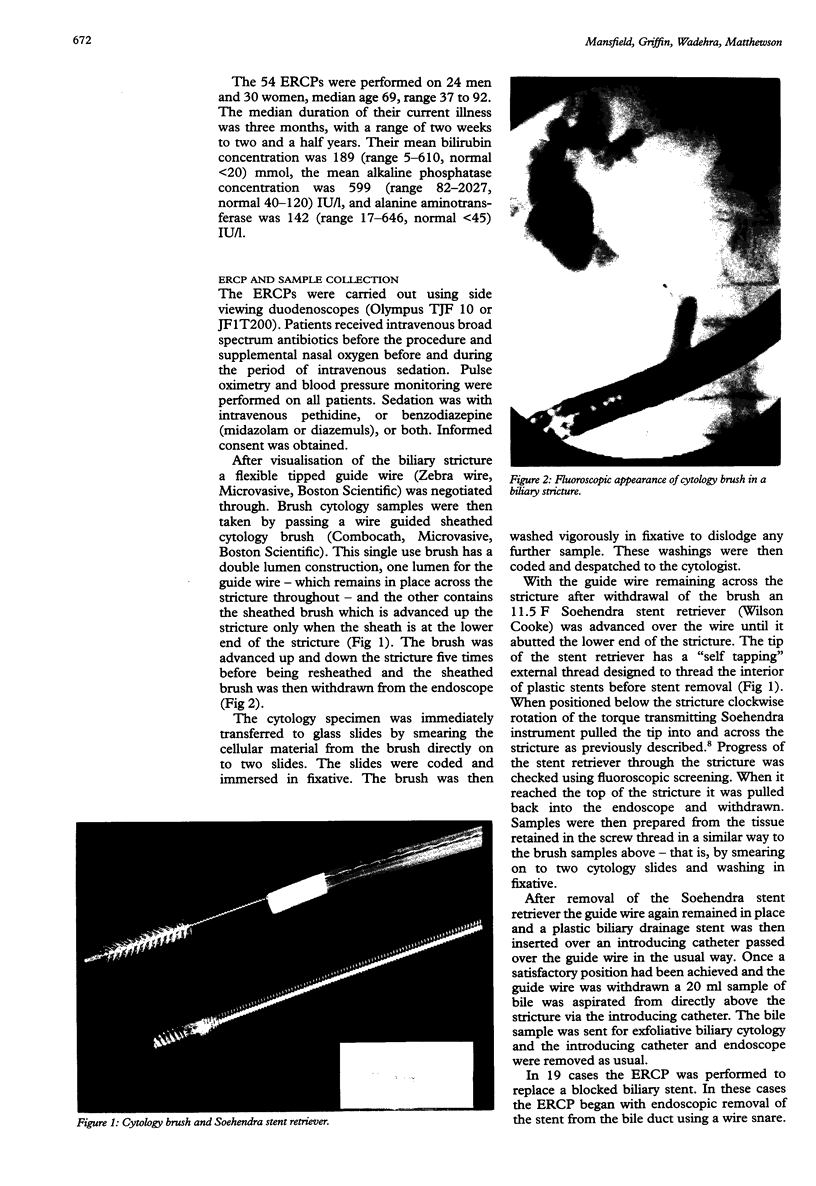



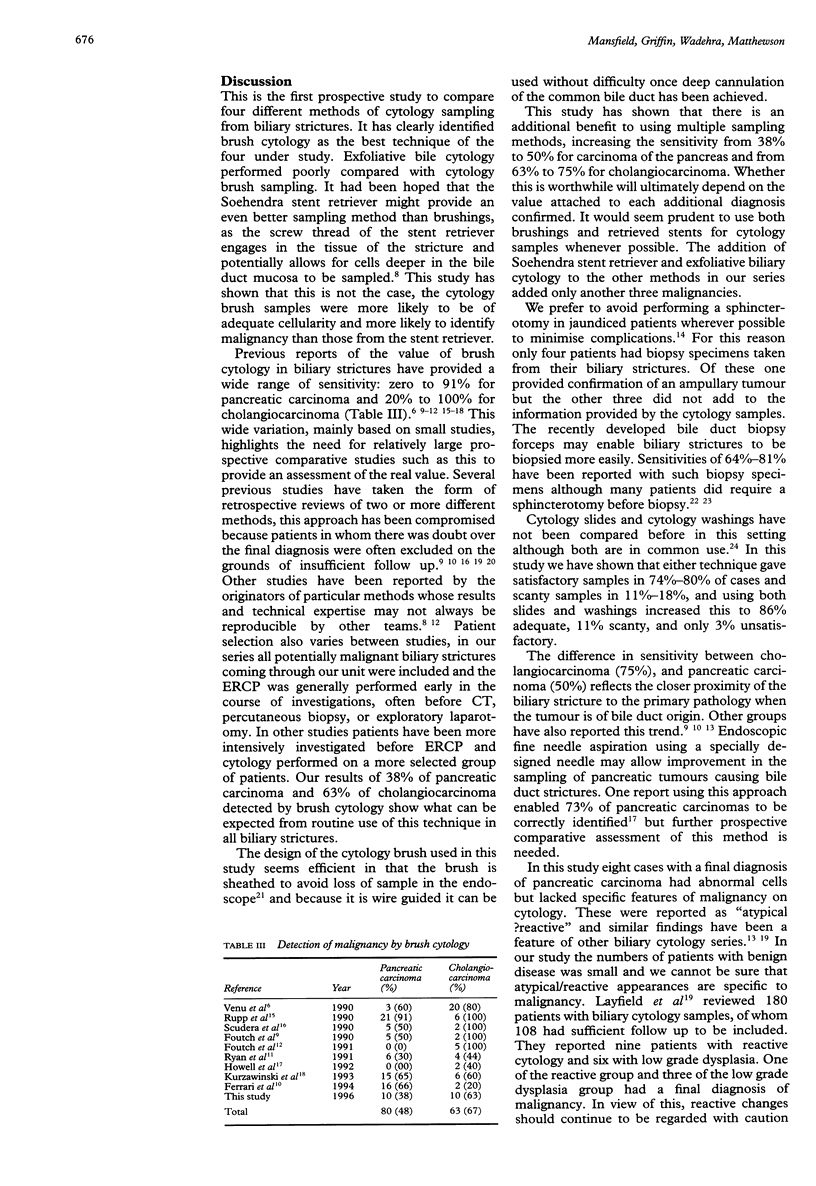
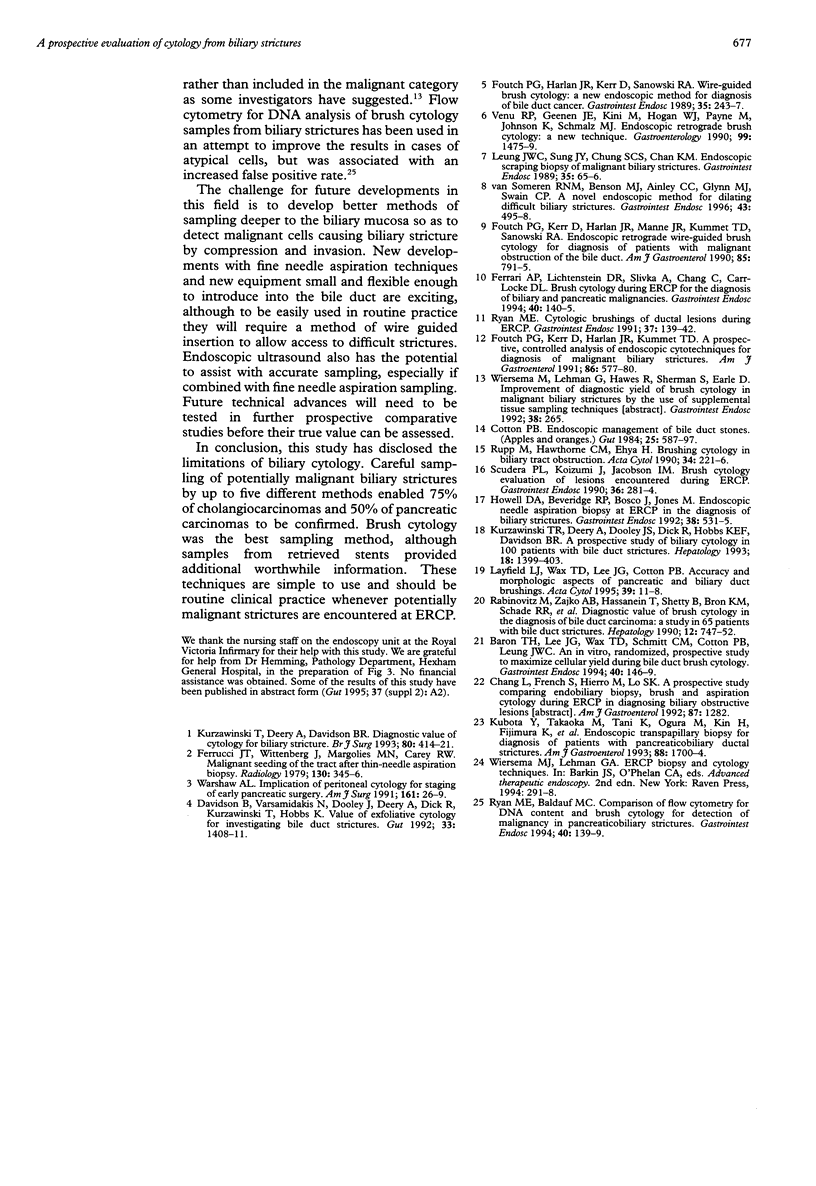
Images in this article
Selected References
These references are in PubMed. This may not be the complete list of references from this article.
- Baron T. H., Lee J. G., Wax T. D., Schmitt C. M., Cotton P. B., Leung J. W. An in vitro, randomized, prospective study to maximize cellular yield during bile duct brush cytology. Gastrointest Endosc. 1994 Mar-Apr;40(2 Pt 1):146–149. doi: 10.1016/s0016-5107(94)70156-3. [DOI] [PubMed] [Google Scholar]
- Cotton P. B. Endoscopic management of bile duct stones; (apples and oranges). Gut. 1984 Jun;25(6):587–597. doi: 10.1136/gut.25.6.587. [DOI] [PMC free article] [PubMed] [Google Scholar]
- Davidson B., Varsamidakis N., Dooley J., Deery A., Dick R., Kurzawinski T., Hobbs K. Value of exfoliative cytology for investigating bile duct strictures. Gut. 1992 Oct;33(10):1408–1411. doi: 10.1136/gut.33.10.1408. [DOI] [PMC free article] [PubMed] [Google Scholar]
- Ferrari Júnior A. P., Lichtenstein D. R., Slivka A., Chang C., Carr-Locke D. L. Brush cytology during ERCP for the diagnosis of biliary and pancreatic malignancies. Gastrointest Endosc. 1994 Mar-Apr;40(2 Pt 1):140–145. doi: 10.1016/s0016-5107(94)70155-5. [DOI] [PubMed] [Google Scholar]
- Ferrari Júnior A. P., Lichtenstein D. R., Slivka A., Chang C., Carr-Locke D. L. Brush cytology during ERCP for the diagnosis of biliary and pancreatic malignancies. Gastrointest Endosc. 1994 Mar-Apr;40(2 Pt 1):140–145. doi: 10.1016/s0016-5107(94)70155-5. [DOI] [PubMed] [Google Scholar]
- Ferrucci J. T., Wittenberg J., Margolies M. N., Carey R. W. Malignant seeding of the tract after thin-needle aspiration biopsy. Radiology. 1979 Feb;130(2):345–346. doi: 10.1148/130.2.345. [DOI] [PubMed] [Google Scholar]
- Foutch P. G., Harlan J. R., Kerr D., Sanowski R. A. Wire-guided brush cytology: a new endoscopic method for diagnosis of bile duct cancer. Gastrointest Endosc. 1989 May-Jun;35(3):243–247. doi: 10.1016/s0016-5107(89)72767-x. [DOI] [PubMed] [Google Scholar]
- Foutch P. G., Kerr D. M., Harlan J. R., Kummet T. D. A prospective, controlled analysis of endoscopic cytotechniques for diagnosis of malignant biliary strictures. Am J Gastroenterol. 1991 May;86(5):577–580. [PubMed] [Google Scholar]
- Foutch P. G., Kerr D. M., Harlan J. R., Manne R. K., Kummet T. D., Sanowski R. A. Endoscopic retrograde wire-guided brush cytology for diagnosis of patients with malignant obstruction of the bile duct. Am J Gastroenterol. 1990 Jul;85(7):791–795. [PubMed] [Google Scholar]
- Howell D. A., Beveridge R. P., Bosco J., Jones M. Endoscopic needle aspiration biopsy at ERCP in the diagnosis of biliary strictures. Gastrointest Endosc. 1992 Sep-Oct;38(5):531–535. doi: 10.1016/s0016-5107(92)70510-0. [DOI] [PubMed] [Google Scholar]
- Kubota Y., Takaoka M., Tani K., Ogura M., Kin H., Fujimura K., Mizuno T., Inoue K. Endoscopic transpapillary biopsy for diagnosis of patients with pancreaticobiliary ductal strictures. Am J Gastroenterol. 1993 Oct;88(10):1700–1704. [PubMed] [Google Scholar]
- Kurzawinski T. R., Deery A., Dooley J. S., Dick R., Hobbs K. E., Davidson B. R. A prospective study of biliary cytology in 100 patients with bile duct strictures. Hepatology. 1993 Dec;18(6):1399–1403. [PubMed] [Google Scholar]
- Kurzawinski T., Deery A., Davidson B. R. Diagnostic value of cytology for biliary stricture. Br J Surg. 1993 Apr;80(4):414–421. doi: 10.1002/bjs.1800800404. [DOI] [PubMed] [Google Scholar]
- Layfield L. J., Wax T. D., Lee J. G., Cotton P. B. Accuracy and morphologic aspects of pancreatic and biliary duct brushings. Acta Cytol. 1995 Jan-Feb;39(1):11–18. [PubMed] [Google Scholar]
- Leung J. W., Sung J. Y., Chung S. C., Chan K. M. Endoscopic scraping biopsy of malignant biliary strictures. Gastrointest Endosc. 1989 Jan-Feb;35(1):65–66. doi: 10.1016/s0016-5107(89)72696-1. [DOI] [PubMed] [Google Scholar]
- Rabinovitz M., Zajko A. B., Hassanein T., Shetty B., Bron K. M., Schade R. R., Gavaler J. S., Block G., Van Thiel D. H., Dekker A. Diagnostic value of brush cytology in the diagnosis of bile duct carcinoma: a study in 65 patients with bile duct strictures. Hepatology. 1990 Oct;12(4 Pt 1):747–752. doi: 10.1002/hep.1840120421. [DOI] [PubMed] [Google Scholar]
- Rupp M., Hawthorne C. M., Ehya H. Brushing cytology in biliary tract obstruction. Acta Cytol. 1990 Mar-Apr;34(2):221–226. [PubMed] [Google Scholar]
- Ryan M. E., Baldauf M. C. Comparison of flow cytometry for DNA content and brush cytology for detection of malignancy in pancreaticobiliary strictures. Gastrointest Endosc. 1994 Mar-Apr;40(2 Pt 1):133–139. doi: 10.1016/s0016-5107(94)70154-7. [DOI] [PubMed] [Google Scholar]
- Ryan M. E. Cytologic brushings of ductal lesions during ERCP. Gastrointest Endosc. 1991 Mar-Apr;37(2):139–142. doi: 10.1016/s0016-5107(91)70671-8. [DOI] [PubMed] [Google Scholar]
- Scudera P. L., Koizumi J., Jacobson I. M. Brush cytology evaluation of lesions encountered during ERCP. Gastrointest Endosc. 1990 May-Jun;36(3):281–284. doi: 10.1016/s0016-5107(90)71024-3. [DOI] [PubMed] [Google Scholar]
- Venu R. P., Geenen J. E., Kini M., Hogan W. J., Payne M., Johnson G. K., Schmalz M. J. Endoscopic retrograde brush cytology. A new technique. Gastroenterology. 1990 Nov;99(5):1475–1479. doi: 10.1016/0016-5085(90)91178-9. [DOI] [PubMed] [Google Scholar]
- Warshaw A. L. Implications of peritoneal cytology for staging of early pancreatic cancer. Am J Surg. 1991 Jan;161(1):26–30. doi: 10.1016/0002-9610(91)90356-i. [DOI] [PubMed] [Google Scholar]
- van Someren R. N., Benson M. J., Glynn M. J., Ashraf W., Swain C. P. A novel technique for dilating difficult malignant biliary strictures during therapeutic ERCP. Gastrointest Endosc. 1996 May;43(5):495–498. doi: 10.1016/s0016-5107(96)70293-6. [DOI] [PubMed] [Google Scholar]





